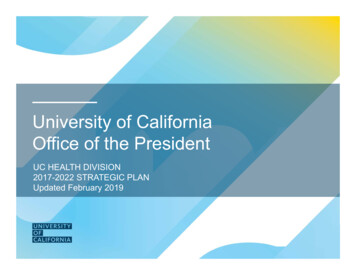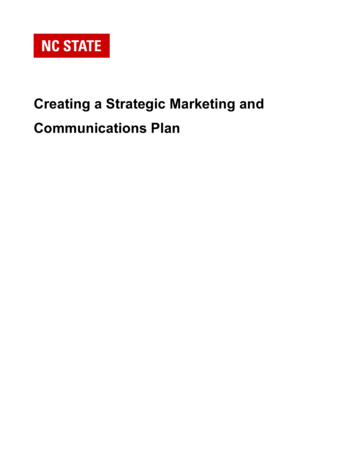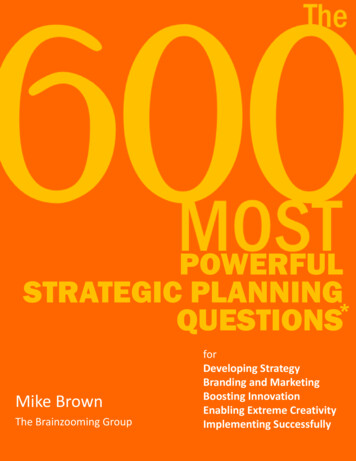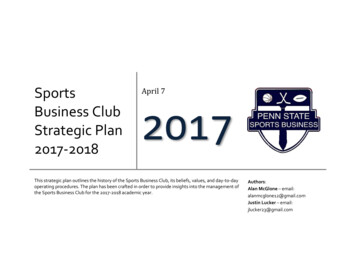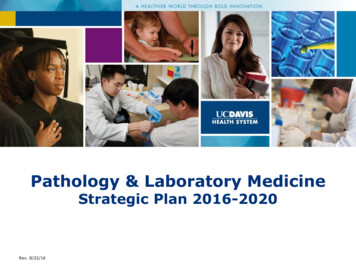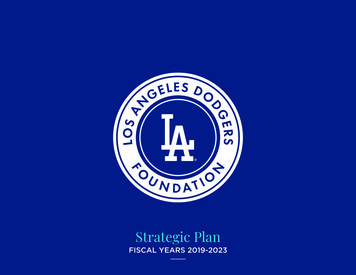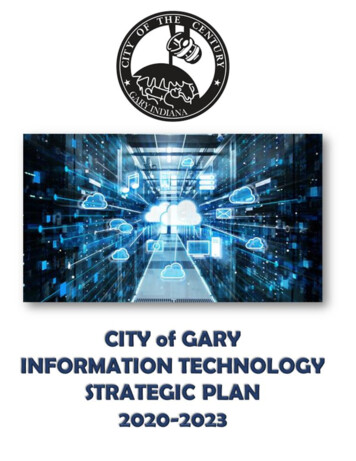
Transcription
1 Page
REVISION1.02.03.04.05.06.0PURPOSEDATEInitial release COG-IT Strategic Plan 3 Sept 2019The 2020 – 2023 Information Technology Strategic Planis now available for internal and public dissemination.Lloyd L. KeithChief Technology Officer2 Page1September 2019Date
IntroductionUnder the leadership of the Mayor, the Information TechnologyDepartment (COG-IT) works with departments across the City of Garyto develop world-class IT infrastructure and applications that provideour citizens, businesses, and visitors with the digital services theyexpect from a leading global city. In an era of transformativetechnology, the opportunities have never been greater to improvethe lives of Gary residents, businesses, and visitors through digitalmeans. In today’s economy there is a demand that we provide theminformation and services digitally. The COG-IT recognizes thisdemand and our unique role as technology leaders in Garygovernment. Our efforts to reach these goals have been challenging But for all of our accomplishments, our City still remains far from theultimate vision of becoming a fully digital and connected city. Thereinlies the importance of strategic planning.Through effective strategic planning and execution, the COG-ITfocuses its resources on overcoming key challenges to enable the Cityof Gary to meet its full potential. As described by famed UCLAprofessor, Richard Rumelt, “Good strategy works by focusing energyand resources on one, or a very few, pivotal objectives whoseaccomplishment will lead to a cascade of favorable outcomes.” Thisdocument seeks to summarize our pivotal objectives for the next threeyears and the challenges they overcome. This strategic plan containsa progressive list of, what we do, upcoming projects, and someaccomplishments. Simply put, this document strives to succinctlysummarize our environment, our focus, and our strategic priorities for2020-23, using what we call “Responsive, Responsible, and ExcellentTech.”3 Page
COG-IT Strategic Plan At A Glance The City of Gary endeavors to be digital and connected to improvethe lives of our residents, businesses and visitors. The COG-IT comprises 5 IT professionals delivering the City’sdifferent technology services. The COG-IT believes the single most important success factor isan in-depth understanding of our customers. Depending on the COG-IT service, our customers are: internalwithin Gary government, residents/businesses as required, or atargeted population. The COG-IT areas of focus Gary’s Workforce, Serve GaryResidents and Businesses via the cities workforce and Visitors. COG-IT’s vision is to become a best-in-class technology departmentthat demonstrates Responsive, Responsible, and ExcellentTechnology. COG-IT’s vision is delivered through: IT Services (“what we do”) IT Projects (“what we build”) IT Metrics (“how well we do it”) These key challenges can significantly hinder the City’s technologyvision and require strategic coordination to resolve:Challenge #1 - Funding ResourcesChallenge #2 - Inconsistent Quality in City TechnologyServices (#5)Challenge #3 – Cybersecurity, Protecting COG DigitalEnterpriseChallenge #4 – Professional DevelopmentChallenge #5 - Aging Technology Infrastructure4 Page
To overcome these challenges, the COG-IT has developedobjectives and projects, known as ‘Our Strategic Priorities for 201921’:Priority #1 - Transform Use of Tech By Every CityDepartmentPriority #2 – Work with Departments to Apply Technology toDirectly Improve Public WelfarePriority #3 - Build Next Generation IT Infrastructure andCapabilitiesPriority #4 - Develop our IT Human ResourcesOur EnvironmentOur ServicesThe COG-IT is comprised of 5 IT professionals with an annual operatingbudget of Xand deliver IT services to both internal and externalcustomers. These range from classic, such as computer support,enterprise applications, data networks, TV stations, 3-1-1 call and onlinesupport, public safety communications, enterprise social media, andcontract IT Support Services to the Gary Chicago International Airport.Our CustomersThe COG-IT believes the single most important success factor in ITservice delivery, is an in-depth understanding of our customers.Depending on the specific COG-IT service, our customers are: Internal within City governmento X# elected officialso X# City employeeso X# City departments External to City governmento X# Gary residentso X# Gary businesses Constituent Serviceso Veterans, homeless or nearly homeless, domestic violencevictims, etc.5 Page
Universities, Colleges, Public and Charter Schools etc.Since our department is small and serves a very broad constituency, weneed to train team members to work very closely with police, fire, andemergency management personnel. We work with our ConstituentServices 3-1-1 service, which engages closely with Council ledcommunity groups, Neighborhood Block Clubs, and the public-at-large,to understand the needs of residents and businesses seeking City ofGary technical services. As such, a critical success factor for COG-IT isour ability identify with City workforce and their customers, understandtheir needs and wants, and deliver IT services that maximize theoutcomes they desire. This is in turn, influences our strategic priorities,investments, and service offerings.Our FocusThe following pyramid summarizes what we do and who we serve on aday-to-day basis:6 Page
Our PhilosophyOur VisionCOG-IT’s vision is to migrate Gary to a Digital and Connected City.Our MissionTo best serve Mayor’s vision, the City of Gary, where COG-IT works tobe a best-in-class technology department that demonstratesResponsive, Responsible, and Excellent Information Technology: Responsive Tech - Delivers business outcomes for every Citydepartment by leveraging agile, flexible services that digitallyengage citizens and employees Responsible Tech - Advocates technologies that promotesustainable choices and offers training opportunities for developinga highly skilled, diverse, and representative workforce Excellent Tech - Achieves excellence in core IT infrastructure,innovation, and cybersecurity to protect the City’s digital assetsHow We Accomplish Our MissionCOG-IT’s mission is achieved through: IT Services Daily operations “what we do” IT Projects Initiatives greater than 80 hours “what we build” IT Metrics Key performance indicators “how well we do it”Through the use of free modern tools, the COG-IT manages itsoperations, projects, and metrics. The following summarizes theframeworks used by COG-IT in these areas:7 Page
We Manage IT ServicesOn a daily basis, COG-IT staff may implement new IT services, repairexisting ones, or develop enhancements. In fact, the COG-IT supportsand maintains software applications, network and server infrastructure,phone communications (fixed and mobile), computer support, publicsafety systems, media communications, Gary Airport system etc.We Manage City Cloud ProjectsThe COG-IT defines projects as a temporary effort to create a new orsubstantially changed product or service. Generally, our IT projects aregreater than 80 hours in staff investment, has identified customerbenefits, and a defined start/stop. Towards the fulfillment of our vision,the COG-IT manages these efforts as projects.We Define Success Through MetricsIf services are what we do and projects are what we build. then metricsare how well we do it. The Information Technology Agency (COG-IT)Metric measurement for COG-IT is in its infancy, the gathering of theright data, data analysis, and the productive use of the analysis inplanning and performance management. In 2017, Mayor FreemanWilson required all City of Gary departments to establish their ownperformance management metrics with monthly reports. This programneeds to be continued and transferred to productive use.8 Page
Key ChallengesNeedless to say, there are many challenges faced by the City of Garythe COG-IT. However, the following are key strategic challenges thatsignificantly hinder the City’s technology vision and require strategiccoordination to resolve.Challenge #1 - Funding ResourcesThe U.S. Conference of Mayors (USCM) discussed three major themes:infrastructure, innovation and inclusion. Siting constituents areimpatient to see progress in all of these areas — and cities have to figureout how to deliver it in the face of serious fiscal constraints. One pathto solving those problems is making their cities “smarter” — that is,harnessing data and digital technology to meet the challenge of doingmore with less. Technology alone cannot solve every urban problem.However, it is a powerful and cost-effective tool for helping citiesaccelerate progress. Thus our Vision to migrate Gary to a Digital andConnected City.Challenge #2 - Inconsistent Quality in City Technology ServicesThe COG-IT has dramatically improved its enterprise digital services,infrastructure, and platforms. The COG-IT is now working closely withother City departments to improve their digital services. City of Garydepartments are varied in their technology prowess. Some departmentshave limited technology expertise or investments. No longer simply thevenue of the “technology department”, technology has becomeubiquitous in just about all business processes. As such, it is critical forall City departments to become effective users of technology for thegood of Gary’s residents, businesses, and visitors. Leveraging lessonslearned by top-performing departments, the COG-IT has the opportunityto use Technology Plans to affect and transform technology deliveryacross the entire City.9 Page
Challenge #3 – Cybersecurity, Protecting COG DigitalEnterpriseAs escalating cyberthreats continue to grab global headlines, localgovernments have been hit particularly hard over the past year. Fromcities to counties to townships, the breadth and depth of attacks haveoverwhelmed many jurisdictions. Factors affecting our cybersecurityefforts: Lack of resources — knowledge of cybersecurity as it applies toour technology applications and infrastructure Aging technology — technology that is no longer supported orunder maintenance contracts. New technology introduction — keeping IT up to date with thenewer technologies, need for knowledgeable technical resources,to protect against threats. Size and scope of local government —larger cities and countieshave IT organizations with FTE’s that handle cybersecuritychallenges. Lack of understanding and funding in key local governmentexecutive roles — in the end, in order to address the issuesabove, it requires funding and support at the executive levels.There must be a recognition that technology is no longer a "backroom" function, that funds must be available to keep thetechnology up to date, and that there must be a "cyber disasterrecovery" plan that has the same focus, funding and resources asany disaster recovery plan.Challenge #4 – Professional DevelopmentA huge issue for our department! Revisit what we do (above), here isthe short list on the issues of what must be done: new technology, cloud,big data, virtualization, BYOD and BYOA, shadow IT, boomers, energyefficiency, user systems, interoperability, creating value and socialnetworks. How to do “know how to do it”? COG-IT will continue to face10 P a g e
issues brought to them by users, customers and departmentalmanagers, while they work toward providing IT solutions that bestsupport organizational priorities.Challenge #5 - Aging Technology InfrastructureIt seems that every time budget cuts are necessary the first departmentto receive cuts is Information Technology. These cuts manifest indramatic reductions in infrastructure investments with deferredmaintenance expenses in both existing infrastructure and replacementprojects. IT Investments in the past two years have made someinfrastructure improvements in the last two years. However, ITinfrastructure is still a major factor in the success of many digitalservices and technology opportunities around the City. Effective ITinfrastructure provides an opportunity to transform City services,increase the effectiveness of the City workforce, and improve the qualityand reliability of services.11 P a g e
Our Strategic Priorities for 2020-23Based on the challenges listed above and our assessment of pivotalobjectives, the following summarizes our strategic priorities andsamples of key projects for 2020-2023. We have determined priorities1 – 5 as being critical and must be addressed in the coming year 2020:1 UPS & Generators – Back-up generators are required in all criticalareas to allow critical business processes to continue when there is apower outage. Currently at City Hall there are no Back-Up Generatorsystems. At a minimum the Telco Room(s) must have its own Back-upgenerator, this site is the central hub for all City Operations. Outageshere is detrimental to having continued service for resiliency. UPSsystems are also required for key equipment and services. Theseequipment’s will be affected by sudden surges of power, which can leadto data corruption and VoIP communication loss when the systemswitches over from main power to a back-up generator. This initiativerequires new Back-Up Generator and UPS systems as project for IT toimplement.2 Storage – As departments are working to digitize files, contracts,certificates and video, the need for storage has increased drastically.Our current storage can only support the daily work environment notthe needed extensive archive storage. A network storage plan isnecessary to support these issues. This initiative requires a new storageenvironment as a project for IT to implement.12 P a g e
3 Computer Replacement – Microsoft has announced that it willofficially begin the Windows 7 end of life phase on Jan. 14, 2020. Onthat day, the company will stop supporting Windows 7 on laptops anddesktops, and will no longer patch it with security updates. Bottom line,any PC, 2-in-1 laptop, tablet or other device that is running on Windows7 will be on its own when fending off hackers. Based on our ScreenConnect Access system we have 622 machines and easily 95% ofthese systems are Windows 7. This upgrade is essential; a rough budgetcost 400K- 500K. We will work with our finance department andvendors to develop the best cost effective options.4 Technology Replacement Program –The purpose of this initiativeis to expand the existing IT refresh/replacement program to includemore IT-related equipment such as switches, routers and servers.Develop the appropriate funding source for equipment maintenance andsupport once warrantees have expired. A thorough analysis of the types13 P a g e
and quantities of equipment to be added, plus determination of thereplacement cycle (number of years) are required in order to determinethe cost of this initiative.5 Complete Disaster Recovery/Business Continuity Plan – Thepurpose of this initiative is to complete the efforts that have begun toaddress development of a DR/BC Plan for the City. Create redundancyin our off line backup solution by providing a secondary location toachieve resiliency. The major cost component for this is to purchaseadditional Backup and Recovery system for the secondary location andIT staff time.6 Increase Use of Fuel Management/GPS Systems – The purposeof this initiative is to take complete advantage of these systemscurrently in our inventory; Online tracking, Fuel control, Routeoptimization, Workforce management, Sensor data reading, Geofencecontrol, Driver behavior monitoring and cost controls. Both systemswere purchased and implemented in 2018 however additional trainingand configuration is required to utilize the benefits of the systems. Thisinitiative requires system configuration corrections, system training and14 P a g e
end user training. The GPS system has a monthly lease cost whichincludes maintenance. No ongoing cost for the Fuel ManagementSystem, maintenance cost will occur after 3 years.7 Gary Common Council Technology Upgrades – This initiativeresolves long overdue technology obsolescence. This plan will provideimproved reliability and increased performance on a digital basis. Thisincreased performance will be obtained via digital cameras, LED lightingfor enhanced picture quality, flat screen LCD monitors (placedstrategically in the council chambers), digital microphones, advancedsound monitoring, a digital sound mixing console and computerizedpresentations. This will be accompanied by a control room built in thecouncil chambers. These innovative additions can be upgraded for yearsto come.8 Streaming Media Communications - Lightcast.com is multiplatform OVP & OTT provider with end-to-end packages for the creationof TV Apps, Mobile Apps, Web Apps and Social Apps and distribution of15 P a g e
live-streams & on-demand media to Roku, FireTV, AppleTV, SmartTVs,AndroidTV, Mobile Apps and Websites. Our award-winning mediamanagement system (CMS) the "Media Cloud" allows content producersand publishers to upload, manage, control and monetize all of theircontents, streams, files, metadata, image & sidecar files, app navigationstructures, across all connected websites, social platforms, mobile appsand TV apps in real-time.9 Include IT in New Employee Orientation – The purpose of thisinitiative is to educate new employees regarding the availability of all ITsystems that can be used to support their job functions. Initialconversations and planning has begun with HR. This initiative includesthe use of the Catalog of IT Products and Services (Catalog must begenerated and maintained described below) and would include a reviewof IT-related policies and procedures, and training opportunities. Themajor cost component of this initiative is IT and HR staff time to preparefor and become a part New Employee Orientations.16 P a g e
10 Create an IT Training Assessment Program – The purpose ofthis initiative is to develop relevant IT-related training programs for newand existing City employees to ensure that they can be as productive aspossible and fully utilize the City’s IT systems. This initiative includesidentification and/or development of an on-line self-assessment toolthat captures employees’ level of knowledge and skill for the various ITsystems they use to perform their work. It also includes development ofa template that assists departments with identifying what systems anew employee would use and ensuring that new employees receivetraining to do so. It would result in the development of personalizedtraining plans based on the results of these activities including ComputerBasics for those employees who are not familiar with using a computer(Windows 10). The major cost component for this initiative is the online self-assessment tool and the resources necessary to create andmanage the training plans. The actual training is another cost factor forthose areas where it does not currently exist.Resource IT Consulting Services for the IT Department – Thepurpose of this initiative is to support the evolution of the COG-ITDepartment to provide consulting and research services for departmentsto ensure that departments are aware of available technology.17 P a g e
Develop Catalog of IT Products/Services – The purpose of thisinitiative is educate new and existing employees regarding theavailability of IT-related products and services, and policies andprocedures related to the use of IT systems. This initiative includescreation of an on-line and hard copy catalog of IT-related products,services, policies, and procedures for internal distribution including useat New Employee Orientations. The major cost component of thisinitiative is IT staff time.City of Gary Intranet – The purpose of this initiative is to providemanagement-level information in a useful format based on the role andresponsibilities of the end user. The City can make use of Office365cloud services such as Microsoft SharePoint for assembling informationand presenting in various ways of on-line access. The major costcomponent of this initiative is related to development of requirements,screen and report design, programming and development costs, as wellas, IT technical and end user training.18 P a g e
Establish IT Super Users Program – The purpose of this initiative isto improve end user support and training for the City’s various ITsystems through identification, training, and support of Super Users;City employees who are not in the IT department but are above averageusers of a particular IT application. This initiative includes identifyingone or more Super Users per department to address the City’s ITapplications; identifying certification programs for Super Users for thevarious IT applications; and identifying means to reward Super Users,such as access to better hardware and software and advanced trainingprograms. (Need to be determined “reward”). The cost of this initiativeis driven by training and certification needs.Redefine Pre and Post-Implementation Training Requirements –The purpose of this initiative is to maximize the training provided byvendors when a new system or major upgrades to an existing systemare implemented. This initiative includes modifying the City’s standard19 P a g e
contract language to require both pre and post-implementation trainingfor end users. Although there is no direct cost involved in changing thecontract terms, the vendor’s cost may increase for providing training inthis manor.IT must be involved in planning and acquisition all City’ssoftware and technology to support this efforts.Deploy Mobile Devices in the Field for Access – The purpose of thisinitiative is to increase remote access to Cardiograph (or its replacementsystem) & Code technology to provide viewing of work order, permitand other related data as well as input of information into the system.This initiative includes providing rugged cased tablets for staff workingin the field and training them to remotely access permit, metering,inspection, crime, and other data from the Cardiograph & Codetechnology. The mobile services consist of AT&T, T-Mobile, and FirstNet.Currently we do not have Mobile Device Management (MDM)capabilities. This allow the City to retain ownership of mobile devices iflost, stolen, locked, and devices not returned upon termination. Themajor cost component is the purchase of tablets and staff training.20 P a g e
Remote Access to Maps & Images – The purpose of this initiative isto provide access to the City’s geographic information system (GIS)maps and data (layers), as-builts, site plans, and other image files inthe field to support decision-making and job performance. This initiativeincludes identifying, organizing, cataloging, updating and publishing theCity’s many image-type files including producing data for use in the fieldand establishing a process to directly download necessary images andmaps to remote devices. It also includes establishing a periodic updateprocess for distribution of new or modified images. The major costcomponent of this initiative is COG and GSD IT staff time to identify,organize, catalog, update, and distribute these images. Additionally,staff working in the field need the proper equipment and training tomake use of these image files. (Collaboration)Implement IT Professional Development– The purpose of thisinitiative is to provide professional development for COG-IT staff:Service Strategy, Service Design, Service Transition, Service Operation,and Continual Service Improvement. This initiative will promotepractices and improve in IT operations and service management. Themajor cost component of this initiative is for COG- IT staff to develop animplementation plan, which include ability to study, certificationfunding, and if available attending certification classes.21 P a g e
Implement Formal Project Management – The purpose of thisinitiative is to begin using a more formal, best practice based projectmanagement methodology. It includes obtaining training, deploying amethodology, and obtaining tools. The major cost factors for thisinitiative are training and the purchase and deployment of ProjectManagement Software tools. This initiative also include the building onthe implementation of IT Governance and establish a process for projectprioritization that includes business case justification. While manymethods exist, the City should implement one that includes measuresbeyond traditional return on investment. Additional cost may beincurred if 3rd party resources are used to define and deploy a bestpractice based methodology.City-Wide Video Surveillance – This initiative continue the coverageof video surveillance of City building, locations and assets. Currently wehave surveillance at: Gary Housing Authority sites, Public Safety, CityHall, Rainbow Shelter, Genesis, General Services, Gleason Park, all FuelStations, and to be added Hudson Campbell. This project includes thedesign, supply and installation of video surveillance systems withcamera upgrades as required. The system will enable the Police, COGIT as well as authorized staff in City facilities remote internet basedaccess to images produced by the cameras, and provide storage andplayback for one month on an automatic basis. Long-term storage canbe provided with convenient access at additional cost. The major costcomponent of this initiative is based on continued assessment of Cityassets and locations that require camera installations or cameraupgrades.22 P a g e
Desktop Alerting and Notification System – In today’s world ofactive shooter and other emergencies instant notification of a crisis toemployees is necessary. An Active Shooter working group is tasked withproviding an emergency plan for city employees to prepare for a possiblecrisis. One aspect of the plan is the Desktop Alerting and NotificationSystem. We will be implementing a one-way alerts and notificationssystem to desktop users, which cannot be skipped, ignored or saved forlater. Alerts carrying varying priorities, customizations, audibility anddelivery options to be distributed across the organization in seconds –each with an accurate, real-time record of receipt andacknowledgement. The major cost component of this initiative is a onetime fee for the system and COG- IT staff to develop an implementationplan.Regional Data Service (RDS) – This initiative maintains the RDSsystem including software support of the system onsite and remote,design services, custom programming services, user training andcustomer representations with outside data processing vendors. Currentapplications software products; Financial Accounting & Report/Web23 P a g e
Purchasing, Payroll/Personnel, Budget Forecasting, Fixed Assets,Construction Contracts, Warehouse Inventory, Online Requisition &Purchase Orders, Work Orders and Report Builder Web. RDS alsoprovides up to 1014 hours of technical support. Technical supportincludes the following, as it relates to the use of RDS's applicationsoftware: Onsite support, Custom programming, Phone Support,Remote dial—in support, Training (not including special training sessionsthat carry additional charges, such as year-end training).RDS Human Resource Module – Human Resource, this RDS initiativeworks with the Applicant Tracking and Employee Access modules toimprove the efficiency of the HR Department, Applicant Tracking Webbased Software that enables the HR Department to create customapplications by job type. Applicants can enter applications on the GaryCity Web site through a secure SSL connection. Employee Access Webbased Software gives employees access to their payroll information suchas pay stubs, leave, benefits etc Employees can print out copies oftheir W2’s and fill out forms established by the HR Department. RDScost is annual, paid in monthly installments.IT Services Gary/Chicago International Airport Authority – Thisinitiative COG-IT provides contract Information Technology services tothe GCIAA. The principal activities required in supporting thisinfrastructure include (but not limited to): Network Assessment,Network Engineering, Network Installation, Network Testing andSupport, Email support, Remote & Onsite Monitoring, Offsite & OnsiteData Backup, IT Consulting & Budgeting, VoIP Telecom and TechnicalSupport. COG-IT impact none at the present time.24 P a g e
Assessment of cumulative progress in 2017 - 2019: Centralize City-wide IT functions to deliver core infrastructureserviceso This is a “living goal”, LAN/WAN – WI-FI Infrastructure (seeattached network diagram)o This function enables the City to deliver scalable data, voiceand video communications on the City’s Metro Area Networkvia AT&T Switched Ethernet (A.S.E.) & Comcast EthernetNetwork Service (E.N.S). The ASE & ENS is currently runningover a combination of fiber optic and copper networks, overthe past year to now, we’ve upgraded connection speedsfrom 4MBS, 10MBS & 100MBS building to building to 500MBSand 1 Gigabyte speeds. Our current needs, the replacement and acquisition ofnetworking equipment which includes; core switches,edge switches, firewalls, routers, gigabit modules, fiber25 P a g e
optic cable, various networking monitoring tools,packet filtering/ traffic shaping devices, andprofessional services. It is essential that we enhancethe core network to eventually 1 Gigabyte.o WI-FI Infrastructure, implementing City-wide WI-FI in allcity buildings. WI-FI access is available for staff (Securelogin) and guest (via request). Because of the recentinfrastructures upgrades WI-FI speeds have increaseddramaticallyo Consulting Services are used when making networkmodifications, which are required for integration of productsor services. Funding is utilized to maintain a secure, viableand reliable COG-Switched Network architecture and toevolve to the next-generation network architecture/protocols. Funds in FY 2017 – FY 2020 have been and will beused for the acquisi
1.0 Initial release COG-IT Strategic Plan 3 Sept 2019 2.0 3.0 4.0 5.0 6.0 The 2020 – 2023 Information Technology Strategic Plan is now available for internal and public dissemination. _ _ Lloy





